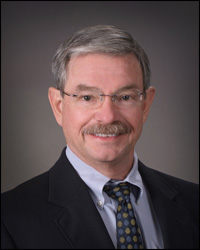Burghardt Wins Distinguished Service Award
COLLEGE STATION, TX – Dr. Robert Burghardt, professor in the veterinary integrative biosciences department of the Texas A&M University College of Veterinary Medicine & Biomedical Sciences, has been honored by the Society for the Study of Reproduction with a Distinguished Service Award.

The society presents this award to individuals who have demonstrated “unselfish service and leadership in advancing the discipline of reproductive biology.” Marked by prestigious leadership positions, teaching awards and prolific contributions to research, Burghardt’s academic career, spanning more than three decades, is a stellar example of this accomplishment.
“It’s a great honor, unexpected, but much appreciated,” Burghardt said, reflecting on the significance of the award.
Burghardt collaborates with a group of reproductive biologists who refer to themselves as the uterine biology and pregnancy team, which was honored in 2005 with the university’s Agriculture Program Vice Chancellor’s “Award in Excellence for Team Research.” The award was in recognition of “exceptional leadership in advancing the understanding of the processes that affect [the] reproductive health of animals to benefit both agriculture and human sciences.”
“Dr. Burghardt is a tremendous asset to our college,” said Dr. Eleanor Green, Carl B. King Dean of Veterinary Medicine. “His commitment to not only his research but also his students has made a significant contribution to animal and human health today and in the future.”
Over the course of his career, Burghardt has published over 200 peer-reviewed papers. He also holds a patent titled “Cryopreservation of tissue for use in nuclear transfer,” along with a fellow colleague and a graduate student. The patent was awarded for developing methods to preserve tissues harvested from animals postmortem for future use in cloning for purposes such as the conservation of endangered species.
Burghardt’s other accomplishments include serving as a grant reviewer for federal agencies such as the National Institutes of Health and the National Science Foundation; serving as the associate editor of the Biology of Reproduction, the Society for the Study of Reproduction’s official journal; and being awarded the Wiley Distinguished Teaching Professorship in Veterinary Medicine.
Burghardt’s work in reproductive biology began at Harvard Medical School, where as a postdoctoral researcher he studied mechanisms underlying communication between ovarian cells in mammalian models. An interest in the use of imaging techniques for research in reproductive biology brought him to Texas A&M University. He joined the university’s department of biology as an assistant professor in 1978 to teach a course in microscopy. He later become associate professor in this department as well as director of the university’s Electron Microscopy Center, posts which he held until 1987.
That same year, Burghardt made the transition to the College of Veterinary Medicine & Biomedical Sciences. He joined the department of veterinary anatomy and public health (now veterinary integrative biosciences) as associate professor. Besides the pursuit of research interests, the transition was motivated by an invitation to develop a laboratory based on emerging microscopy technologies, which resulted in Burghardt founding the college’s Image Analysis Laboratory in 1987.
In addition to investigating how smooth muscle cells in the uterus are activated during the induction of labor, Burghardt’s research projects include studying the mechanisms of cell signaling between the placental and fetal tissue compartments during the establishment and maintenance of pregnancy and studying mechanisms of cytotoxicity using non-invasive fluorescence imaging techniques.
Further, under Burghardt’s direction, the Image Analysis Laboratory has become one of the premier cellular imaging facilities in the nation. It has also served as a core facility for projects funded by major grants from the National Institute of Environmental Health Sciences, for example, the Superfund Research Program.
“For the college to be on the forefront of imaging, we have to find the funding to purchase a new instrument every 2 or 3 years,” Burghardt says.
He aims to continue to provide state-of-the-art analytical microscopy resources and training facilities to students and researchers to utilize this technology to advance their research.
Reflecting on his career, Burghardt credits the college for giving him “the perfect job,” one that has allowed him to balance and enjoy his many academic interests.
“I’ve been very lucky to have the opportunity to teach the courses I really like,” Burghardt says. “I’ve been fortunate to work with colleagues and trainees in research areas that are very stimulating and motivating and to have the opportunity to provide service through the Image Analysis Laboratory.”


